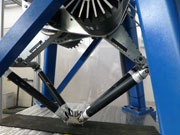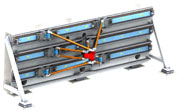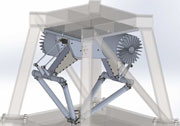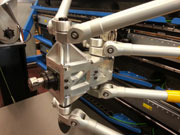Parallel kinematics Systems
Scientific community has addressed many research topics. This work was mainly specific and as an example, we can cite in an unsorted manner: kinematics, dynamics, singularities, type-synthesis, dimensional synthesis, control, simulation, calibration, identification, design, technology, performance indices, reconfigurable devices and experiments. A good control of these points is requested to obtain a convincing running prototype with potential applications in industry as a special machine or as a commercially available product. As a short list of products that have reached the industrial market, we can mention:
Indeed, it is worth to notice that despite the huge research effort devoted to this domain, only few products are available on the market. The main explanations lie on one hand in the fact that such robots can seem complex and require a big research investigation an on the other hand that academic research is split into specialized domains. Moreover, when prototypes or demonstrators are built, the goal is to validate theories through experiments and not to convince industrial partners for future products or applications. Nevertheless, some demonstrators are built in that way and allow meeting industrial applications. On a research point of view, theory has to face today’s state of the art technological limitations in several points like:
Content Different session formats will be planned:
The topics tackled during the sessions are:
Invited lecturers Chosen among the most well-known experts worldwide, the lecturers have a significant theoretical and practical background in parallel kinematic mechanisms communities: Jean Pierre Merlet, INRIA, FranceAndreas Müller, Johannes Kepler University Linz, Austria Manfred Husty, University of Innsbruck, Austria Mohamed Bouri, EPFL, Switzerland Stéphane Caro, Sébastien Briot, IRCCyN, CNRS, France Sébastien Krut, Ahmed Chemori, Olivier Company, Marc Gouttefarde, LIRMM, UM/CNRS, France Lectures and school materials All lectures will be given in English. The lecturers' slides will be available online at the time of the class. The students are advised to bring their own laptop with a running Matlab version and a “student version” of ADAMS software. ECTS The 36-hour courses of the Summer School will be accredited by the Doctoral School on Information, Systems and Structure (I2S) of the University of Montpellier (a Doctoral School in the French Universities manages the Ph.D. degree). 5 ECTS credit points will be awarded to student attendees. Accommodation The lectures will be given at the "Mercure Hotel, La Grande Motte Port", which is located at La Grande-Motte (seaside resort near Montpellier). Further details on how to get there. The attendees will be sharing apartments for two to three persons. |
||||||||||||



